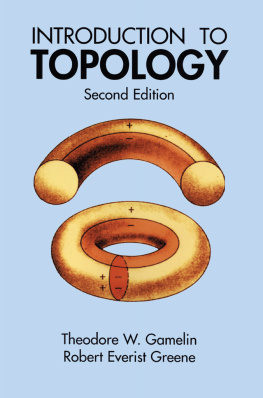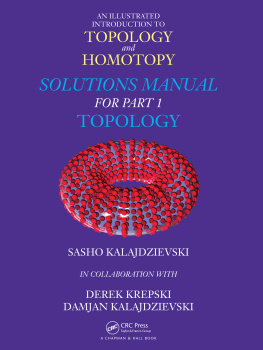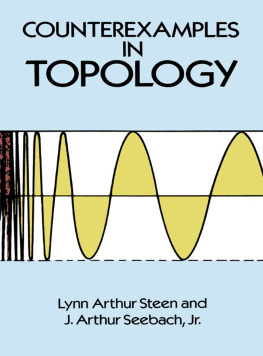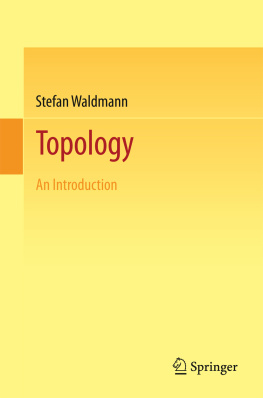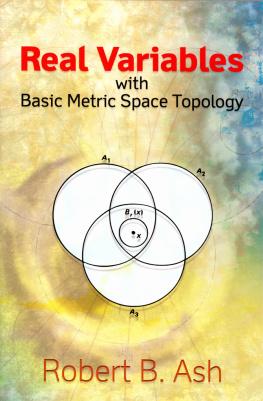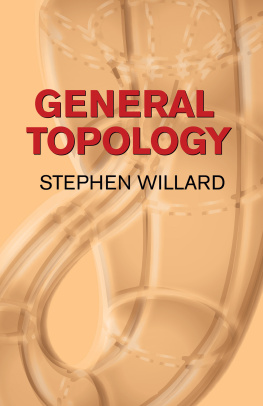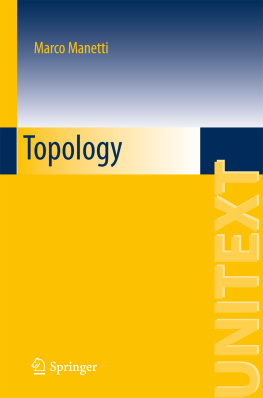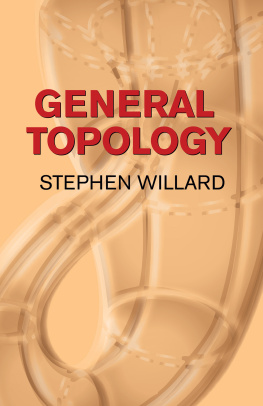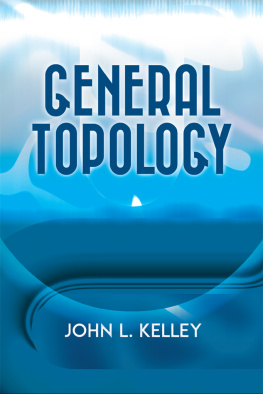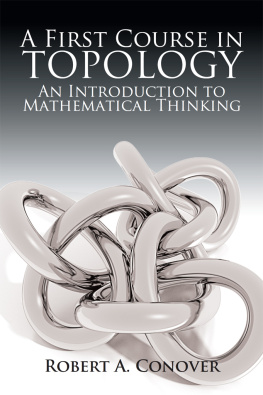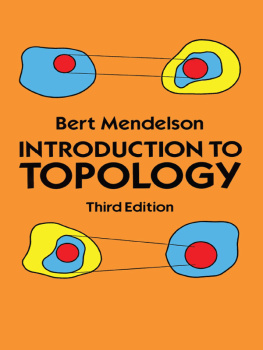Dover Publications. - Introduction to Topology
Here you can read online Dover Publications. - Introduction to Topology full text of the book (entire story) in english for free. Download pdf and epub, get meaning, cover and reviews about this ebook. City: Mineola, year: 2013;1983, publisher: Dover Publications, genre: Home and family. Description of the work, (preface) as well as reviews are available. Best literature library LitArk.com created for fans of good reading and offers a wide selection of genres:
Romance novel
Science fiction
Adventure
Detective
Science
History
Home and family
Prose
Art
Politics
Computer
Non-fiction
Religion
Business
Children
Humor
Choose a favorite category and find really read worthwhile books. Enjoy immersion in the world of imagination, feel the emotions of the characters or learn something new for yourself, make an fascinating discovery.
- Book:Introduction to Topology
- Author:
- Publisher:Dover Publications
- Genre:
- Year:2013;1983
- City:Mineola
- Rating:5 / 5
- Favourites:Add to favourites
- Your mark:
- 100
- 1
- 2
- 3
- 4
- 5
Introduction to Topology: summary, description and annotation
We offer to read an annotation, description, summary or preface (depends on what the author of the book "Introduction to Topology" wrote himself). If you haven't found the necessary information about the book — write in the comments, we will try to find it.
Introduction to Topology — read online for free the complete book (whole text) full work
Below is the text of the book, divided by pages. System saving the place of the last page read, allows you to conveniently read the book "Introduction to Topology" online for free, without having to search again every time where you left off. Put a bookmark, and you can go to the page where you finished reading at any time.
Font size:
Interval:
Bookmark:
to
Topology
Second Edition
Theodore W. Gamelin
and
Robert Everist Greene
DOVER PUBLICATIONS, INC.
Mineola, New York
Copyright
Copyright 1983, 1999 by Theodore W. Gamelin and Robert Everist Greene
All rights reserved.
Bibliographical Note
This Dover edition, first published in 1999, is an unabridged reprint of the first edition of Introduction to Topology, published by W B Saunders Company, Philadelphia, in 1983. The authors prepared a new addendum, Solutions to Selected Exercises, especially for this edition.
Library of Congress Cataloging-in-Publication Data
Gamelin, Theodore W.
Introduction to topology / Theodore W. Gamelin, Robert Everist Greene. 2nd ed.
p. cm.
An unabridged reprint of the first edition published by W.B. Saunders Company, Philadelphia in 1983. A new addendum has been added.
Includes index.
ISBN 0-486-40680-6 (pbk.)
1. Topology. I. Greene, Robert Everist, 1943- . II. Title.
QA611.G35 1999
514dc21
99-14612
CIP
Manufactured in the United States by Courier Corporation
40680606
www.doverpublications.com
To our parents
Frank and Ruth Gamelin
Lee and Dorothy Greene
One of the most important developments in mathematics in the twentieth century has been the formation of topology as an independent field of study and the subsequent systematic application of topological ideas to other fields of mathematics. Ideas that are topological in nature occurred explicitly in the nineteenth century and in embryonic form even earlier. The part of topology most relevant to analysis, that part usually called point-set topology or general topology, had its beginnings in the nineteenth-century works that first established calculus on a rigorous basis. The beginnings of the second large branch of topology, algebraic and geometric topology, are from an even earlier period; for instance, Eulers results in the eighteenth century on the combinatorics of polyhedral figures were already a clear precursor of contemporary ideas. However, the systematic investigation of topology as a separate field of mathematics, which began in the late nineteenth century and continues unabated today, has given the ideas of topology both new generality and new depth. By now, the ideas of point-set topology are a large part of the basic language and technique of analysis. The methods of algebraic topology play an important role in algebra as well as forming a large field of mathematics unto themselves. Also, the great growth of differential geometry in recent times is associated with a viewpoint involving topological concepts.
The by now well-established importance of topology has led naturally to the writing of many works on the subject, including a large number of introductory texts. The purposes of the present text are, however, somewhat different from those of most introductory topology texts. First, we have attempted early in the book to lead the reader through a number of nontrivial applications of metric space topology to analysis, so that the relevance of topology to analysis is apparent both with more immediacy and also on a deeper level than is commonly the case. Second, in the treatment of topics from elementary algebraic topology later in the book, we have concentrated upon results with concrete geometric meaning and have presented comparatively little algebraic formalism; at the same time, however, we have provided proofs of some highly nontrivial results (e.g., the noncontractibility of Sn). These goals have been accomplished by treating homotopy theory without considering homology theory. Thus the reader can immediately see important applications without undertaking the development of a large formal program. We hope that these applications, besides having intrinsic interest, will lead the reader toward the detailed study of algebraic topology with the feeling that putting its methods on a formal, general basis is well worthwhile. The metric space and point-set topology material occupies the first two chapters, the algebraic topological material the remaining two chapters.
This book arose from our experiences in teaching introductory courses in various aspects of topology to upper division undergraduate students and beginning graduate students. All the material was found accessible by the students, but it could not all be covered in a single one-term course. The book is arranged so that considerable flexibility in the choice of topics is possible. in toto. In all cases, starred sections, which are in general of somewhat greater difficulty than the other material, can be omitted without detriment to understanding of later portions of the text.
In the strict logical sense, the book is almost independent of prior mathematical knowledge. Only familiarity with the real numbers and with some basic set theory, such as countability and uncountability, is needed in this strict sense. Readers who are not to some extent familiar with the subject usually called rigorous calculus (e.g., definitions of limits and continuity) may find the material a strain on their capacity to absorb abstraction without concrete motivation. Readers familiar with rigorous calculus will recognize easily that are generalized expressions of phenomena that occur in concrete form in rigorous calculus. Throughout, readers are urged to construct for themselves many concrete illustrations of the general definitions and results. Topology is a subject that, in spite of its appearance of abstractness, is deeply rooted in the concrete and geometrically comprehensible world; the development of intuitive insight by consideration of these roots is a vital part of learning topology, but it is a part that one must do largely for oneself. In this connection also, we strongly urge the reader to do as many of the exercises as possible. Topology is as much a mode of thought as it is a body of information, and mastery of the mode of thought cannot be really well developed by passive reading alone. This remark applies to most mathematics, but it seems to us to apply especially strongly to the learning of topology. Thus the exercises are to us an integral part of the text, and readers should so treat them. In any case, it is more fun to play the game than just to learn the rules.
Cross references to lemmas, theorems and exercises are handled with notations such as III.4.7 or in which the reference occurs. A list of special symbols is given at the end of the book, as are various bibliographical references.
We thank with pleasure the many students and colleagues at UCLA who gave us encouragement and valuable comments on the preliminary lecture notes from which this book evolved over the past eight years. We especially thank Laurie Beerman for her fine job typing the various revisions of the manuscript.
University of California
Los Angeles, California
THEODORE W. GAMELIN
ROBERT EVERIST GREENE
Introduction
to
Topology
Second Edition
The ideas of metric and metric space, which are the subject matter of this chapter, are abstractions of the concept of distance in Euclidean space. These abstractions have turned out to be particularly fundamental and useful in modern mathematics; in fact, the aspects of the Euclidean idea of distance retained in the abstract version are precisely those that are most useful in a wide range of mathematical activities. The determination of this usefulness was historically a matter of experience and experiment. By now, the reader can be assured, the mathematical utility of the metric-space information developed in this chapter entirely justifies its careful study.
Font size:
Interval:
Bookmark:
Similar books «Introduction to Topology»
Look at similar books to Introduction to Topology. We have selected literature similar in name and meaning in the hope of providing readers with more options to find new, interesting, not yet read works.
Discussion, reviews of the book Introduction to Topology and just readers' own opinions. Leave your comments, write what you think about the work, its meaning or the main characters. Specify what exactly you liked and what you didn't like, and why you think so.

